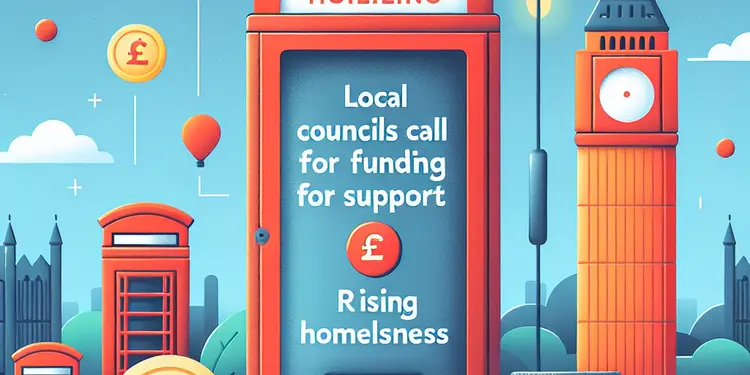
Find Help
More Items From Ergsy search
-

How do funding and resources affect SEND support?
Relevance: 100%
-

What support is available outside of school for SEND children?
Relevance: 53%
-

What support is available for SEND children in schools?
Relevance: 53%
-

What are SEND children?
Relevance: 50%
-

What role do teachers play in supporting SEND children?
Relevance: 46%
-

Do SEND children attend mainstream schools?
Relevance: 44%
-

Who are SEND children?
Relevance: 44%
-

Can SEND children access extracurricular activities?
Relevance: 43%
-

Mental Health Support Resources in the UK
Relevance: 42%
-

How are parents involved in the SEND process?
Relevance: 42%
-

What are some common misconceptions about SEND?
Relevance: 42%
-

Mental Health Support Resources for Families
Relevance: 41%
-

What does SEND stand for?
Relevance: 40%
-

Mental Health Support for Families - Latest Resources and Guidance
Relevance: 40%
-

How can schools create an inclusive environment for SEND children?
Relevance: 38%
-

Are there specific laws governing SEND in schools?
Relevance: 38%
-

Mental Health Support for Families: Resources and Strategies
Relevance: 38%
-

Mental Health Support for Families: Resources and Guidance
Relevance: 38%
-

Mental Health Support for Families: Resources and Helplines
Relevance: 38%
-

Accessing Mental Health Support Resources in the UK
Relevance: 38%
-

Can I send money to an inmate?
Relevance: 38%
-

Can SEND status change over time?
Relevance: 36%
-

What can pension fund members do if their fund is at risk of failing?
Relevance: 36%
-

Addressing the Rising Cost of Living: Community Support and Resources
Relevance: 36%
-

Who is responsible for assessing SEND needs?
Relevance: 36%
-

Addressing the Cost of Living Crisis: Community Support and Resources
Relevance: 36%
-

How is progress measured for SEND children?
Relevance: 35%
-

What are some common types of SEND?
Relevance: 35%
-

Local Councils Call for More Funding to Support Rising Homelessness
Relevance: 34%
-

Mental Health Impact of Cost of Living Crisis and Support Resources
Relevance: 34%
-

How are Postcode Lottery funds allocated?
Relevance: 34%
-

Advancements in Mental Health Resources for Families
Relevance: 33%
-

Why do pension funds go bust?
Relevance: 33%
-

What funding options are available for nursing students in the UK?
Relevance: 33%
-

Who provides the funding for free school meals in the UK?
Relevance: 33%
-

What items can I send to someone in prison?
Relevance: 32%
-

How do I send books or magazines?
Relevance: 32%
-

How do water companies fund infrastructure updates?
Relevance: 32%
-

What is the Pension Protection Fund?
Relevance: 32%
-

Government Announces Funding Boost for Digital Health Innovations
Relevance: 31%
Introduction
The provision of support for children and young people with Special Educational Needs and Disabilities (SEND) in the UK is critically influenced by the availability of funding and resources. Adequate funding and the efficient allocation of resources are essential to ensure that SEND students receive the necessary educational support tailored to their individual needs.
The Role of Funding
Funding plays a pivotal role in determining the quality and accessibility of SEND support. Schools and local authorities rely on allocated budgets to employ specialized staff, such as SEND coordinators and teaching assistants, and to provide essential resources and services. The level of funding can directly impact the class sizes, availability of one-on-one support, and the quality of tailored educational materials. When funding is adequate, schools can invest in assistive technologies, training programs for staff, and inclusive teaching practices that benefit SEND students.
Impact of Resource Allocation
Efficient resource allocation is crucial for maximizing the impact of available funds on SEND support. Resources must be strategically deployed to address the varying needs of SEND students, from those requiring minor classroom adjustments to those needing intensive, individualized interventions. Proper allocation enables schools to maintain necessary support staff and develop targeted programs that cater to a diverse range of disabilities and conditions. It also ensures that resources such as sensory rooms, adapted equipment, and learning aids are available when needed.
Challenges Faced by Schools
Despite the best intentions, many UK schools face challenges due to funding constraints and resource limitations. These challenges can lead to unmet needs, larger class sizes, and overburdened staff, all of which can negatively affect the quality of SEND education. Funding cuts and budgetary restrictions often result in schools struggling to maintain current support levels, let alone improve them. This can be particularly pronounced in areas with higher numbers of SEND students, where demand for resources is greater.
The Importance of Government Policy
Government policy plays a vital role in determining the level of funding and resources allocated to SEND support. Policies that prioritize increased investment in education and specifically target SEND programs can lead to improvements in support services. Additionally, initiatives aimed at ensuring accountability and transparency in how funds are used can help optimize resource distribution and ensure that funds reach the students who need them most.
Conclusion
The interplay between funding, resources, and government policy is central to the effectiveness of SEND support in the UK. Adequate funding and judicious resource allocation not only enable schools to meet the needs of SEND students but also contribute to a more inclusive education system where all children have the opportunity to reach their full potential. As such, ongoing advocacy for increased investment and strategic policy-making remains crucial to overcoming the challenges faced in SEND education.
Introduction
Helping children with Special Educational Needs and Disabilities (SEND) in the UK depends a lot on money and resources. Schools need enough money and the right resources to support these children in the best way possible.
The Role of Funding
Money is very important for helping SEND students. Schools use this money to hire special staff like SEND coordinators and teaching assistants. They also buy important tools and services. More money can mean smaller classes, more helpers, and better learning tools. Schools can also get cool technologies and teach their staff the best ways to help SEND students.
Impact of Resource Allocation
Using resources well is important to help SEND students. Schools need to use what they have efficiently to help students in different ways. Some students need small changes in the classroom, while others need a lot of help. Proper use of resources means keeping good staff and making programs that help many children. It also means having things like sensory rooms and special tools when needed.
Challenges Faced by Schools
Many schools in the UK have problems because they don’t have enough money or resources. These problems can mean students don’t get the help they need, classes are too big, and teachers have too much work. When there are budget cuts, schools struggle to keep helping students with the right level of support. This is harder in places with more SEND students because they need more help.
The Importance of Government Policy
The government’s rules matter a lot for how much money and resources SEND support gets. If the government gives more money and support to SEND programs, support can get better. Policies that make sure the money is spent well help the students who need it most.
Conclusion
Having enough money, smart use of resources, and good government policies are all key to supporting SEND students in the UK. More money and careful planning help schools ensure all children can succeed. It’s important to keep asking for more support and smart policies to solve the challenges in SEND education.
Frequently Asked Questions
What is SEND support?
SEND support refers to the assistance provided to children and young people with Special Educational Needs and Disabilities (SEND) to help them succeed in school and other educational settings.
How does funding impact SEND support?
Funding impacts SEND support by determining the availability and quality of resources, specialized staff, and tailored programs that can be offered to meet the needs of students with SEND.
What types of resources are important for SEND support?
Important resources include specialized equipment, trained staff, individualized educational plans, therapy services, and accessible learning materials.
Who provides funding for SEND support?
Funding for SEND support can come from government sources, local education authorities, charitable organizations, and sometimes private funding.
How do funding cuts affect SEND support?
Funding cuts can lead to reduced services, fewer staff, larger class sizes, and less individualized attention, which can negatively impact the quality of education and support for SEND students.
Why is adequate funding crucial for SEND support?
Adequate funding ensures that SEND students receive necessary accommodations and support to fully access the curriculum and achieve their potential.
What role do local authorities play in SEND funding?
Local authorities are responsible for allocating funding and resources to support SEND in schools and other educational institutions.
Can lack of resources affect a SEND student's educational outcomes?
Yes, lack of resources can hinder a SEND student's ability to access the curriculum, participate fully in school activities, and achieve academic success.
How do schools prioritize funds for SEND support?
Schools prioritize funds based on the specific needs of their SEND students, often focusing on staffing, specialized services, and necessary equipment.
What is an Education, Health and Care Plan (EHCP)?
An EHCP is a legal document that outlines the education, health, and social care support a child with SEND needs and often dictates the level of funding required.
How does government policy affect SEND funding?
Government policy determines the overall budget for education, including SEND support, and sets the framework for how funds are allocated to different areas.
What challenges do schools face in providing SEND support?
Challenges include insufficient funding, lack of specialized staff, inadequate training, large class sizes, and limited access to resources.
How can parents advocate for better SEND funding?
Parents can advocate by collaborating with schools, joining local advocacy groups, reaching out to policymakers, and participating in public consultations on education budgets.
What is the impact of well-funded SEND support on student outcomes?
Well-funded SEND support can lead to improved academic performance, better social integration, higher motivation, and increased chances of success in higher education and employment.
Are there disparities in SEND support funding across regions?
Yes, disparities can exist due to differences in local authority budgets, demographic needs, and the prioritization of SEND support in different regions.
How often is SEND funding reviewed and adjusted?
SEND funding is typically reviewed annually, but adjustments can be made more frequently in response to changes in student needs or policy shifts.
Can schools supplement SEND funding with private sources?
Yes, schools can seek additional funding from charitable organizations, grants, and donations to supplement government support for SEND.
What happens if a school lacks sufficient SEND funding?
Schools may struggle to provide effective support, which can lead to unmet needs, decreased student satisfaction, and potentially greater challenges for SEND students.
How can technology enhance SEND support with adequate funding?
Technology can provide personalized learning experiences, assistive devices, and innovative teaching methods that can greatly enhance SEND support when funding is available to access such tools.
What role do educational charities play in SEND funding?
Educational charities can provide additional support, resources, and funding for SEND initiatives, helping to fill gaps left by limited government funding.
What is SEND support?
SEND support helps children who have special educational needs or disabilities. This support makes learning easier for them.
Here are some ways to help:
- Extra help from a teacher or helper.
- Using special tools, like computers or books with big letters.
- Changing lessons to make them easier to understand.
If your child needs SEND support, talk to their teacher or school.
SEND support is help for children and young people who need extra help to learn. This is for kids with Special Educational Needs and Disabilities. It helps them do well in school and other places where they learn.
How does money help schools support children with SEND?
SEND means Special Educational Needs and Disabilities.
Money helps schools give the right support to children with SEND. Here is how:
- More Teachers: With more money, schools can hire more teachers. This means more help for each child.
- Special Tools: Money helps buy special tools, like computers or toys, that make learning easier.
- Training: Teachers can learn new ways to help children with SEND when there is more money.
Tools and tips to help:
- Visual Aids: Pictures and videos can make learning fun and easy.
- Audio Books: Listening to books is a great way to learn.
- Breaks: Taking short breaks can help children focus better.
- Routines: Having a daily plan helps children know what to expect.
How much money a school has can change how they help students with SEND. It affects what tools and support they can offer. It also decides if they can hire special teachers and make programs just for those students.
What help is important for children with special needs?
Some children need extra help at school. Here is what can help them:
- Books and Tools: Some children use special books or tablets to help them learn.
- Teachers: Teachers who know how to help children with special needs are important.
- Learning Helpers: Some children have a helper who works with them in class.
- Special Classes: There might be special classes for learning in different ways.
- Calm Spaces: A quiet place can help if things get too noisy.
Ask your teacher or parent if you need any help. They can talk to the school to get the right support for you.
Important things that can help include special tools, teachers who know how to help, plans made just for you, therapy, and materials that are easy to understand.
Who pays for SEND help?
Money to help children with special educational needs and disabilities (SEND) can come from a few places: the government, local councils, charities, and sometimes private sources.
What happens to SEND help when there is less money?
When there is less money for schools, they may have to make cuts. This means they might have fewer teachers and bigger classes. It can also mean less help for kids who need extra support. This can make school harder for children. They might not get as much help from teachers.
Here are some things that can help:
- Using simple timers and planners can help keep track of time and tasks.
- Apps that read text out loud can help with reading.
- Talking with a teacher or a helper can also make things easier.
Why is enough money important for SEND help?
SEND means Special Educational Needs and Disabilities. Children with SEND need extra help to learn and grow.
Having enough money is important because:
- It pays for teachers and helpers who can give the right support.
- It buys special tools or equipment to help children learn.
- It makes sure classrooms are safe and easy to use for everyone.
Good support helps children with SEND do well in school and be happy.
Some helpful tools are:
- Visual aids like pictures and charts.
- Learning apps and computer programs.
- Quiet spaces for children to relax.
All children deserve the chance to do their best!
Enough money helps children with special educational needs and disabilities (SEND) get the help they need in school. This means they can learn and do their best.
What do local councils do for SEND money?
Local councils help pay for support for children with special educational needs and disabilities (SEND).
They choose how the money is used to help schools and families.
Parents and teachers can ask the council for help if they need it.
For more help, you could use pictures or videos to understand better.
Local councils give money and help to schools so they can support children with special educational needs and disabilities (SEND).
Can having not enough resources change how well a SEND student does in school?
A SEND student is someone who needs extra help with learning. If there are not enough tools or support, it might be harder for them to learn and do well in school.
Here are some ways to help:
- Use simple language when speaking and writing.
- Give clear and short instructions.
- Use pictures and illustrations to explain ideas.
- Repeat important information to remember it better.
Yes, not having enough resources can make it hard for a SEND student to learn, join in school activities, and do well in their school work.
How do schools decide where to spend money for SEND help?
Schools have money to help students who need extra support. These students might have trouble learning or need special help. This is called SEND support.
Schools think hard about how to use the money for SEND help. They have to decide what is the most important thing to spend money on. Sometimes they buy special tools, like computers or learning games, to help students learn. Other times they hire teachers who know how to give special help.
Schools also listen to what families say. Parents can tell schools what help their children need most. Schools work with families and students to make good choices.
If you need help reading, you can use tools like read-aloud apps. These apps can read the words to you. You can also ask someone to explain words you don't understand.
Schools use their money to help students with special needs (SEND). They often spend on teachers, special help, and important equipment for the students.
What is an Education, Health and Care Plan (EHCP)?
An Education, Health and Care Plan (EHCP) is a plan that helps a child or young person who needs extra support. It says what they need help with in school, for their health, and in their everyday life.
If you want to understand more about EHCPs, you can:
- Ask teachers or helpers at school to explain it to you.
- Use pictures and diagrams to help you understand.
- Talk with family or friends. They might be able to help explain it too.
An EHCP is a legal piece of paper. It says what help a child with SEND needs. It talks about school, health, and other help. It also says how much money is needed for this help.
How does the government decide money for SEND?
The government decides how much money is spent on education. This includes money to help children who need extra support, like those with special educational needs and disabilities (SEND). The government also makes rules on how this money is divided and used.
What problems do schools have with helping SEND students?
SEND students are children who need extra help. Here are some problems schools face when helping them:
- Not enough money: Schools may not have enough funds to buy the tools they need.
- Lack of trained staff: There may not be enough teachers who know how to help SEND students.
- Too many students: Classrooms might have too many children, making it hard to give each SEND student the attention they need.
- Lack of resources: Schools might not have the books, software, or equipment needed for SEND support.
To help, students and parents can:
- Use technology, like special apps, to help with learning.
- Work with teachers to create a plan that fits the student.
- Ask for extra time or breaks if needed in class.
There are some problems:
- Not enough money.
- Not enough trained teachers.
- Teachers need more learning.
- Too many kids in one class.
- Not enough books and tools.
How can parents ask for more money to help children with special needs?
Parents want to help their children who have special needs. Sometimes, children need more help at school. Schools need money to give this help.
Parents can ask for more money in these ways:
- Talk to teachers and school leaders. Tell them what their child needs.
- Join groups with other parents. Together, they can ask for more help.
- Write letters to people in charge, like people in the government. Explain why more money is important.
- Attend meetings to talk about school issues. Speak up about the need for more support.
These actions can help schools get more money to support all children with special needs.
Parents can help by working with schools, joining local groups, talking to people who make rules, and taking part in meetings about education money.
How does good money for SEND help students do better?
SEND means Special Educational Needs and Disabilities. This is help for students who need extra support.
When schools get enough money to support SEND students, these students can do better in school.
Here are some ways to help SEND students:
- Teachers can have special training to know how to help.
- Small classes can give more attention to each student.
- Special tools, like computers, can help with learning.
- Teaching assistants can give extra help when needed.
When students get the right help, they can learn more and feel happy at school.
When schools have good money for SEND support, kids with special needs do better in their school work. They make friends more easily, feel more excited to learn, and have a better chance at going to college or getting a job.
Does SEND support money differ in different areas?
Yes, there can be unfair differences because of how much money each local area has, what people in the area need, and how much each area focuses on helping children with special educational needs.
How often is SEND funding checked and changed?
SEND funding is looked at every year. Sometimes, changes can happen sooner if a student's needs change or if there are new rules.
Can schools get extra money from other places to help children with special needs?
Schools get money to help students with special needs. This is called SEND funding.
Sometimes, schools might need more money to help these students.
They can look for extra money from other places. This might include asking for donations or getting support from charities.
Ask a teacher or school helper if you have questions. They can help explain more.
Yes, schools can ask for more money from charities, grants, and donations to help children with special educational needs and disabilities (SEND). This money is extra to what the government gives.
What if a school does not have enough money for SEND?
If a school does not have enough money for Special Educational Needs and Disabilities (SEND), it might face some problems:
- There may not be enough support for children who need extra help.
- Teachers might not have the tools or training they need to help all students.
- Some students might not get the help they need to learn well.
It is important for schools to have enough money to help every child. Here are some ideas that might help:
- Ask for help from local groups or charities that support SEND.
- Use easy-to-understand tools like picture cards or simple apps.
- Talk to parents and teachers to find the best ways to help each child.
Sometimes schools find it hard to give the right help to all students. This can mean some students do not get what they need. It can make students unhappy and make things harder for those who need extra support.
How can technology help students with special needs if there is enough money?
When we have money to get them, technology can really help children who need extra support in school. It can give them learning that fits just for them, tools to help them, and new fun ways to learn.
How do educational charities help with SEND money?
Educational charities are groups that want to help children who need extra support at school. They can use their money to help schools and families get what they need for these children.
This can mean buying special learning tools or helping teachers learn how to support children better.
Charities can also work with the government to make sure children with SEND get the right help.
Some useful tools or techniques for understanding this are:
- Talking to a teacher or someone you trust about what educational charities do.
- Using pictures or videos to see how charities help in real life.
Educational charities can help in lots of ways. They give extra support, useful resources, and money for special needs programs. This helps when the government doesn’t have enough money to help everyone.
If you need a bit of help reading, try using tools like audiobooks or text-to-speech apps. They can make learning easier and more fun!
Useful Links
- Ergsy carfully checks the information in the videos we provide here.
- Videos shown by Youtube after a video has completed, have NOT been reviewed by ERGSY.
- To view, click the arrow in centre of video.
- Most of the videos you find here will have subtitles and/or closed captions available.
- You may need to turn these on, and choose your preferred language.
- Go to the video you'd like to watch.
- If closed captions (CC) are available, settings will be visible on the bottom right of the video player.
- To turn on Captions, click settings .
- To turn off Captions, click settings again.
More Items From Ergsy search
-

How do funding and resources affect SEND support?
Relevance: 100%
-

What support is available outside of school for SEND children?
Relevance: 53%
-

What support is available for SEND children in schools?
Relevance: 53%
-

What are SEND children?
Relevance: 50%
-

What role do teachers play in supporting SEND children?
Relevance: 46%
-

Do SEND children attend mainstream schools?
Relevance: 44%
-

Who are SEND children?
Relevance: 44%
-

Can SEND children access extracurricular activities?
Relevance: 43%
-

Mental Health Support Resources in the UK
Relevance: 42%
-

How are parents involved in the SEND process?
Relevance: 42%
-

What are some common misconceptions about SEND?
Relevance: 42%
-

Mental Health Support Resources for Families
Relevance: 41%
-

What does SEND stand for?
Relevance: 40%
-

Mental Health Support for Families - Latest Resources and Guidance
Relevance: 40%
-

How can schools create an inclusive environment for SEND children?
Relevance: 38%
-

Are there specific laws governing SEND in schools?
Relevance: 38%
-

Mental Health Support for Families: Resources and Strategies
Relevance: 38%
-

Mental Health Support for Families: Resources and Guidance
Relevance: 38%
-

Mental Health Support for Families: Resources and Helplines
Relevance: 38%
-

Accessing Mental Health Support Resources in the UK
Relevance: 38%
-

Can I send money to an inmate?
Relevance: 38%
-

Can SEND status change over time?
Relevance: 36%
-

What can pension fund members do if their fund is at risk of failing?
Relevance: 36%
-

Addressing the Rising Cost of Living: Community Support and Resources
Relevance: 36%
-

Who is responsible for assessing SEND needs?
Relevance: 36%
-

Addressing the Cost of Living Crisis: Community Support and Resources
Relevance: 36%
-

How is progress measured for SEND children?
Relevance: 35%
-

What are some common types of SEND?
Relevance: 35%
-

Local Councils Call for More Funding to Support Rising Homelessness
Relevance: 34%
-

Mental Health Impact of Cost of Living Crisis and Support Resources
Relevance: 34%
-

How are Postcode Lottery funds allocated?
Relevance: 34%
-

Advancements in Mental Health Resources for Families
Relevance: 33%
-

Why do pension funds go bust?
Relevance: 33%
-

What funding options are available for nursing students in the UK?
Relevance: 33%
-

Who provides the funding for free school meals in the UK?
Relevance: 33%
-

What items can I send to someone in prison?
Relevance: 32%
-

How do I send books or magazines?
Relevance: 32%
-

How do water companies fund infrastructure updates?
Relevance: 32%
-

What is the Pension Protection Fund?
Relevance: 32%
-

Government Announces Funding Boost for Digital Health Innovations
Relevance: 31%


